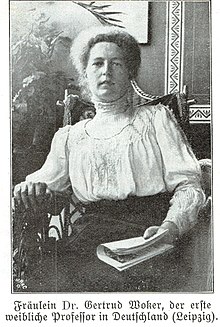Gertrud Woker
Gertrud Woker | |
|---|---|
 | |
| Born | 16 December 1878 |
| Died | 13 September 1968 (aged 89) |
| Education | University of Berne |
| Known for | campaigning against the use of poison gas in warfare. |
| Scientific career | |
| Institutions | University of Berne |
| Thesis | Synthesen des 3,4-Dioxyflavons (1903) |
Gertrud Johanna Woker (16 December 1878 – 13 September 1968) was a Swiss suffragette, biochemist and toxicologist, and peace activist. She wrote for over twenty years itemizing the dangers of chemical substances on the human body. She campaigned against the use of poison gas in warfare.
Early life
[edit]Woker was born on 16 December 1878 to "Old Catholic" theology and history professor Philipp Woker.[1] She came from a well-educated family as besides her father being a professor, her maternal grandfather taught history.[2] Woker was keen to continue her studies but her father sent her to Erfurt to learn to cook. Undeterred, Woker studied mathematics secretly at night with the brother of a fellow student. Leading a double life proved to be an exhausting and Woker fell ill with chlorosis, a form of anaemia.[1]
Education and career
[edit]Woker went on to obtain her PhD and school teaching qualification in chemistry, physics and botany from the University of Berne.[1] Upon her graduation in 1903, she was the first Swiss woman to earn a PhD at the University of Berne.[3] Upon her return to Bern, Woker was unable to find a position in her field and became a high school gymnastics teacher. This was short-lived, however, as she then chose to study at Berlin University as a guest, since women were forbidden to be students.[3] She returned home and worked in Konstanecki's laboratory and synthesized a-naphthoflavanol, flavanone, and flavone. By 1907, she held the title of Probleme der katalytischen Forschung at the University of Bern.[2]
She was soon promised an adjunct professorship, which would make her the first woman in Switzerland with that title. However, soon World War 1 struck and the government said that because of financial strain they could not promote her.[4]
Between 1910 and 1931, Woker wrote four volumes of books regarding the dangers of chemical substances on the human body.[3] From 1911 until her retirement, Woker was the head of the physical-chemical biology laboratory at the University of Berne.[3] In her lab, she conducted studies on peroxidase and catalase, detection methods for natural products and in particular color reactions on sterols.[5] However, her main focus of interest was poisonous gas in war.[6] In 1916, Woker was denied the title of professorship again, this time by a tied vote.[4]
In April 1924, Naima Sahlbom and Woker attended the conference of the American Chemical Society in Washington. During a practice of chemical weapons at an arsenal, they surveyed the severity of scientific warfare. Due to a shift in wind, Sahlbom, Woker, and several scientists were exposed to tear gas.[7] In November 1924, the Fourth International Congress of the WILPF convened in Washington, D.C. At the meeting, Ester Akesson-Beskow, Sahlbom, and Woker announced the formation of the Committee Against Scientific Warfare, of which Sahlbom was the chairwoman.[8] In 1925, Woker published "The coming war of Poison Gas" and sent appeals to Women's International League for Peace and Freedom.[3] This was a result of apprehension from parties to appeal the Geneva Convention. She was specifically concerned about the use of mustard gas and the effect it had on the body.[9]
In 1933, she was granted the title of professorship.[3] She retired in 1951 and wrote a two-volume book on the "chemistry of natural alkaloids 1953-1956". She eventually died on 13 September 1968.[5]
Selected publications
[edit]The following is a list of selected publications:[10]
- Die Chemie der natürlichen Alkaloide: mit besonderer Berücksichtigung ihrer Biogenese
- Die Katalyse. Die Rolle der Katalyse in der analytischen Chemie
- Der kommende Giftgaskrieg
- Der kommende Gift- und Brandkrieg und seine Auswirkungen gegenüber der Zivilbevölkerung
- Erwerbsarbeit der Frau und Rassenentwicklung
References
[edit]- ^ a b c "Gertrud Jan Woker". epigenesys.eu. Archived from the original on 7 July 2022. Retrieved 24 September 2019.
- ^ a b Oesper, Ralph E. (1953). "GERTRUD WOKER". Journal of Chemical Education. 30 (9): 435. Bibcode:1953JChEd..30..435O. doi:10.1021/ed030p435.
- ^ a b c d e f Livia Simon Sarkadi; Jan Apotheker (27 April 2011). European Women in Chemistry. John Wiley & Sons. ISBN 9783527636464. LCCN 2012397275. OL 26093749M. Retrieved 24 September 2019.
- ^ a b Joy Dorothy Harvey; Marilyn Bailey Ogilvie (2000). The Biographical Dictionary of Women in Science: L-Z. Taylor & Francis. p. 1392. ISBN 9780415920384. LCCN 99017668. OL 7495890M. Retrieved 24 September 2019.
- ^ a b "Woker, Gertrud Obituary" (PDF). frauen-streiken.ch (in German). Archived from the original (PDF) on 1 March 2021. Retrieved 24 September 2019.
- ^ Major-General C. H. Foulkes (31 January 2012). "GAS!" — The Story of the Special Brigade. Andrews UK Limited. p. 30. ISBN 9781781503812. LCCN 35001237. OL 8930869M. Retrieved 24 September 2019.
- ^ Woker, Gertrud. "The Next War, a War of Poison Gas". Women and Social Movements in the United States, 1600-2000. Retrieved 2016-12-05.
- ^ "'Newsletter from Geneva,' November 1924". Women and Social Movements in the United States, 1600-2000. Retrieved 2016-12-05.
- ^ Bridget Goodwin (1998). Keen as Mustard: Britain's Horrific Chemical Warfare Experiments in Australia. University of Queensland Press. pp. 73–75. ISBN 9780702229411. LCCN 98217406. OL 487581M. Retrieved 24 September 2019.
- ^ "Woker, Gertrud". worldcat.org. Retrieved 24 September 2019.
